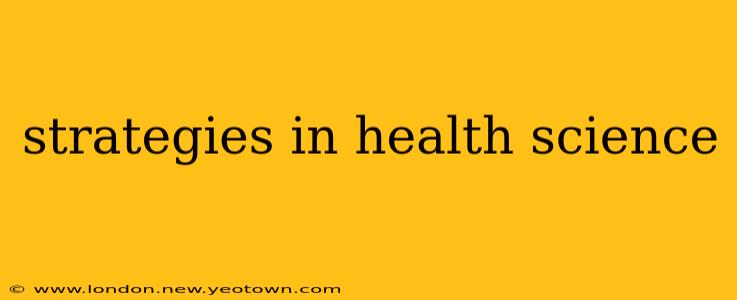The world of health science is a dynamic landscape, constantly evolving to meet the ever-changing needs of a global population. This isn't just about treating illnesses; it's about preventing them, promoting wellness, and ultimately improving the quality of life for everyone. To achieve this, a diverse range of strategies are employed, each playing a crucial role in advancing our understanding and improving healthcare outcomes. Let's embark on a journey to explore some of the key strategies shaping the future of health science.
What are the main strategies in health science research?
Health science research employs a multifaceted approach, drawing on various strategies to achieve its objectives. These strategies often overlap and complement each other. Some key approaches include:
-
Evidence-Based Medicine (EBM): This cornerstone strategy emphasizes the use of the best available research evidence to guide clinical decision-making. It involves a systematic approach to searching, appraising, and applying research findings to individual patient care. EBM isn't just about reading studies; it's about critically evaluating their validity, relevance, and applicability to specific contexts.
-
Translational Research: This bridges the gap between basic scientific discoveries and their application in clinical practice. It involves moving research findings from the laboratory bench to the patient's bedside, accelerating the development of new diagnostic tools, treatments, and preventative measures. Translational research is a crucial link between fundamental research and tangible improvements in patient care.
-
Public Health Interventions: These strategies focus on population-level health improvements, targeting risk factors and implementing preventative measures to reduce disease burden. This can include vaccination campaigns, health education initiatives, and policy changes to promote healthier lifestyles. The impact of these interventions is often measured on a large scale, assessing changes in disease rates and overall population health.
-
Big Data Analytics in Health: The explosion of health data – from electronic health records to genomic information – has created opportunities for innovative analyses. Big data strategies utilize advanced computational techniques to identify trends, patterns, and insights that can improve diagnosis, treatment, and disease prediction. This approach requires sophisticated data management and analysis expertise.
What are the different types of research methodologies used in health sciences?
Health science research utilizes a variety of methodologies, each suited to answering different types of questions:
-
Quantitative Research: This involves collecting and analyzing numerical data, often using statistical methods to identify relationships between variables. Examples include randomized controlled trials (RCTs), cohort studies, and case-control studies. Quantitative methods are particularly valuable for establishing cause-and-effect relationships and testing hypotheses.
-
Qualitative Research: This focuses on understanding the experiences, perspectives, and meanings individuals attach to health and illness. Methods include interviews, focus groups, and ethnographic studies. Qualitative research provides rich contextual information and in-depth insights that complement quantitative findings.
-
Mixed Methods Research: This combines quantitative and qualitative approaches to gain a more comprehensive understanding of a research problem. It leverages the strengths of both approaches, providing a more holistic view than either method alone. Mixed methods are increasingly popular in health science research as researchers recognize the value of integrating different perspectives.
What are some examples of successful health science strategies?
Numerous successful health science strategies have significantly improved global health. Some noteworthy examples include:
-
The eradication of smallpox: A testament to the power of global collaboration and vaccination campaigns.
-
The dramatic reduction in polio cases: A continuing success story demonstrating the effectiveness of widespread vaccination efforts.
-
The development of highly active antiretroviral therapy (HAART) for HIV/AIDS: Revolutionizing treatment and improving the quality of life for millions.
-
Advances in cancer treatment: Including targeted therapies and immunotherapies, offering new hope for patients with various types of cancer.
How can health science strategies be improved?
Despite considerable progress, challenges remain. Improving health science strategies requires:
-
Increased funding for research: To accelerate discoveries and translate them into clinical practice.
-
Strengthening global collaborations: To address transnational health challenges effectively.
-
Promoting health equity: Ensuring access to quality healthcare for all populations, regardless of socioeconomic status or geographic location.
-
Integrating technology and innovation: Utilizing advancements in artificial intelligence, big data analytics, and other technologies to enhance healthcare delivery and research.
The future of health science hinges on our ability to continue innovating and adapting our strategies. By embracing interdisciplinary collaborations, investing in research, and prioritizing health equity, we can achieve even greater advancements in improving global health and well-being.

